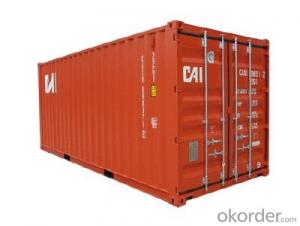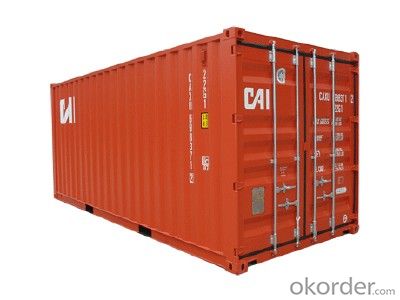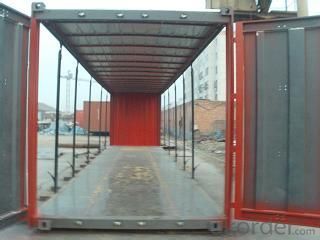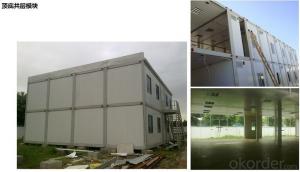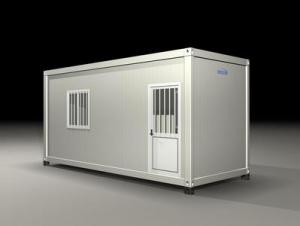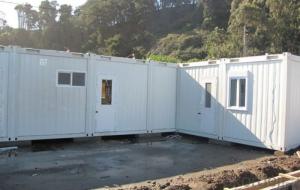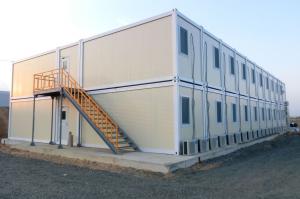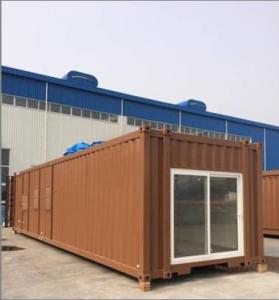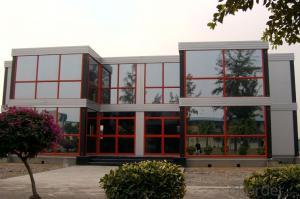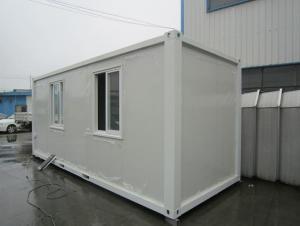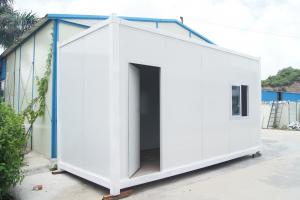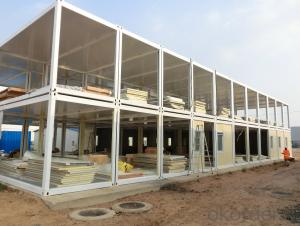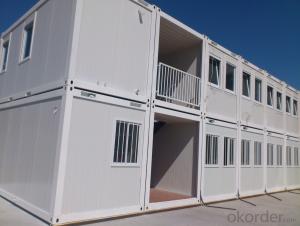CONTAINER HOME,CONTAINER HOUSE
- Loading Port:
- China Main Port
- Payment Terms:
- TT OR LC
- Min Order Qty:
- -
- Supply Capability:
- -
OKorder Service Pledge
OKorder Financial Service
You Might Also Like
Container House
cost-efficient, expandable in each direction, transportable
Container House
1. GENERAL
The standard container for various purposes is suitable for international container transport. It is of appropriate external dimensions and has connections for lifting and fixing or compounding. The container is designed as a light construction consisting of floor and roof frames and corner profiles. The construction enables compounding of individual containers in longitudinal and transverse directions without limits. It also enables compounding of containers in 2 floors in height (ground floor + first floor), or in 3 floors in height for warehousing of these containers (ground floor + 2 floor).
The wainscots of the container are made of light insulation panels and offer pleasant climate in the interior due to their building and physical properties.
Delivery: Containers can be delivered assembled or individually in kits 648 mm high.4 kits can be bundled in packages 2591 mm high (ISO dimensions)
2. DIMENSIONS and TARE (ISO Standard 1161)
-External length 20/(inner length) 20: 6.055m/(5.851m)
-External width/(inner width): 2.435m/(2.231m)
-External height/inner height: 2.790m/(2.510m)
-Tare: 1950 Kgs
3. STEEL FRAMEWORK
3.1 Material: cold formed steel profiles in a thickness of 3 to 4mm (bottom rails).
3.2 Surface working: electric galvanization min 15 μm, zinc compatible epoxy ground coat in a thickness of 30μm , final zinc compatible vinyl acrylic coat in a thickness of 60-70μm.
3.3 Fittings: 8 comer fittings (dimensions according to ISO standard 1161), rainwater pipe in the roof framework, plate thickness of 10mm excluding top corner fittings of the top kit of each bundle (20mm thickness)
3.4 Forklift openings: openings for fork-lift pockets in the floor framework, dim 88×250mm in a distance of 1200mm
4 .FLOOR
4.1 Composition:
-external wainscot: flat galvanized steel sheet metal in a thickness of 0.5mm.
-insulation filling: non combustible mineral wool in a thickness of 100 mm among steel transverse supports. Mineral wool density: 60 Kg/m3
-steam blockade: PE foil in a thickness of 80μm
- plywood panel in a thickness of 18mm
-glued PVC flooring covering in a thickness of 1.5mm.
4.2 Permitted loading : 2.50 KN/m2
4.3 Coefficient of thermal conductivity: l=0.039 W/mK
4.4 R value (Thermal Resistance) = 2.56 m2K/W
4.5 XPS insulation option: it is possible to choose an alternative insulation filling: extruded polystyrene (XPS) in a thickness of 80 mm among steel transverse supports.
XPS density :35 kgs/cubic meter
Coefficient of thermal conductivity: l=0.029 W/mK
R value (Thermal Resistance) = 2.76 m2K/W
5. CEILING:
5.1 Composition:
-external wainscot: flat galvanized and painted steel sheet metal in a thickness of 0.5mm.
-insulation filling: non combustible mineral wool in a thickness of 100mm among plywood purlins. Mineral wool density: 60 Kg/m3
-steam blockade: PE foil in a thickness of 80μm
-inner wainscot: chip wood panel in a thickness of 9 mm with a foil in white color; joining of chip wood panels with PVC profiles
5.2 Meteor water outlet: 4 each of PVC rainwater pipes, diameter 50mm in corner pillars
5.3 Permitted loading: 1.50 KN/m²
5.4 Coefficient of thermal conductivity: l=0.039 W/mK
5.5 R value (Thermal Resistance) = 2.56 m2K/W
6. FACADE WALLS
6.1 Side panels width: 1145mm; total panel thickness: 70mm.
Five panels fit into the long side and two panels fit into the short
side of container and they are fully interchangeable
6.2 Composition:
-External wainscot: galvanized and painted steel sheet metal in a thickness of 0.5mm.
-Insulation filling: non combustible mineral wool in a thickness of 50mm in the wood framework. Mineral wool density: 60 Kg/m3
-Inner wainscot: chip wood panel in a thickness of 9 mm with a foil in wood pattern (bright oak or white).
Joining of panels with PVC profiles. Final elements in the interior are made of chip wood panel in a thickness 8mm with a foil in wood pattern.
6.3 Permitted loading: 1.00 KN/m²
6.4 Coefficient of thermal conductivity: l=0.039 W/mK
6.5 R value (Thermal Resistance) = 1.28 m2K/W
6.6 100 mm insulation option: the framework can be modified so that mineral wool insulation reaches a thickness of 100mm. In this case R value (Thermal Resistance) goes up to: 2.56 m2K/W.
Note that 100 mm thick wall panels are not fully interchangeable like standard 50 mm ones
7. DOORS
Standard external door. Single fold, 40mm thick, made of:
· a frame in prepainted aluminum
· hot galvanized and prepainted steel sheets (inside and outside)
· insulated with PL (polystyrene)
Opening dimensions of 808×2030mm, furnished with a handle lock with 3 keys.
Net opening dimensions: 754 x 1985 mm.
Also 845 x 2000 mm net opening is available.
8. WINDOWS
8.1 Windows
Option 1: made of PVC, white color, with dimensions 800×1100mm, glazed with double layer glass in a thickness of 4/15/4mm, with sliding mechanism (one side fixed and one sliding)
Option 2: made of PVC, white color, with dimensions 800×1100mm, glazed with double layer glass in a thickness of 4/15/4mm, with tilt and swing mechanism
Option 3: made of PVC, white color, with dimensions 800×1200mm, glazed with double layer glass in a thickness of 4/15/4mm, with tilt and swing mechanism
8.2 Rolling shutters
Option 1: external PVC rolling shutters in PVC guides.
Option 2: external Aluminum rolling shutters without insulation in Aluminum guides.
Option 3: external Aluminum rolling shutters with insulation in Aluminum guides.
9. ELECTRICAL INSTALLATIONS
9.1 Standard: according to VDE 100 and CE regulations
9.2 Voltage: 220 V, 60 Hz single phase
9.3 Network connections: CEE-connection plus/socket, 3-pole 32 A, 220V, mounted on the top frame in upper corners of a shorter side wall
9.4 Inner distribution system: BVVB cables of suitable dimensions (6, 2.5, 1.5 mm) ,CE marked , flush-mounted.
All cables (located on the ceiling and inside wall panels) run into CE certified plastic conduits. Roof cables and panel cables are connected with CE compliant jacks. All jack connections are protected inside CE marked and IP44 rated distribution boxes.
9.5 Protection: protective current switch (40/2E-0,03A), automatic fuses (B-characteristics) of suitable power (10A, 16A)
9.6 Earthing: galvanized connector with a steel plate of
dimensions 30x80mm welded on the bottom frame
- Q: Are container houses suitable for families?
- Yes, container houses can be suitable for families. These structures can provide affordable and sustainable housing options, with enough space to accommodate families of various sizes. With proper design and customization, container houses can offer all the necessary amenities and living areas required for a comfortable family life.
- Q: Can container houses be designed to have a modern bathroom?
- Yes, container houses can definitely be designed to have a modern bathroom. With the right planning and design, container houses can be transformed into stylish and functional living spaces with all the amenities of a modern home, including a modern bathroom. There are several ways to achieve a modern bathroom in a container house. Firstly, the interior layout of the container can be modified to accommodate the necessary plumbing and fixtures. This may require professional assistance to ensure proper installation and compliance with building codes. Next, the bathroom design can incorporate modern materials and finishes. For example, sleek and contemporary fixtures, such as a rainfall showerhead, floating vanity, and wall-mounted toilet, can create a modern aesthetic. Additionally, using high-quality materials like glass, porcelain, and chrome can further enhance the modern look. Lighting is another crucial aspect of a modern bathroom design. Incorporating well-placed, energy-efficient LED lights can create a bright and inviting space. Task lighting, such as vanity lights or illuminated mirrors, can provide ample lighting for daily grooming activities. In terms of storage, modern bathrooms often feature clean lines and minimalistic designs. Installing built-in storage solutions, such as recessed shelves or cabinets, can help maximize space and maintain a clutter-free environment. Furthermore, incorporating smart home technology into the bathroom can add an extra touch of modernity. Features like motion-activated lighting, voice-controlled showers, and programmable temperature controls can enhance convenience and efficiency. In conclusion, container houses can absolutely have modern bathrooms. By carefully planning the layout, selecting contemporary fixtures and materials, prioritizing lighting and storage, and integrating smart home technology, container houses can be transformed into modern, stylish, and functional living spaces.
- Q: Can container houses be designed to have a fireplace?
- Container houses can indeed be designed with a fireplace. Despite the fact that containers are typically made of steel, which is not traditionally used for constructing fireplaces, there are methods to integrate a fireplace into a container house design. One common approach involves utilizing a wood-burning stove or a closed combustion fireplace, both of which can be installed within a specially designated area that permits proper ventilation and safety precautions. Furthermore, modifications can be made to the container to include a chimney or venting system, ensuring that smoke is safely directed outside. It is absolutely crucial to seek guidance from professionals well-versed in container home construction and fireplace installation. This will ensure that all necessary safety measures are adhered to and that the design aligns with local building codes and regulations.
- Q: Can container houses be designed with a built-in wine cellar or storage?
- Yes, container houses can definitely be designed with a built-in wine cellar or storage. While container houses are known for their compact and innovative designs, they can be modified to include various amenities, including wine cellars or storage areas. These spaces can be custom-designed to suit the homeowner's needs and preferences, ensuring the proper storage and display of wine bottles. Additionally, container houses offer the advantage of being easily customizable, allowing for the integration of features like temperature control, humidity regulation, and proper insulation to create the ideal environment for storing wine. With the right design and modifications, container houses can accommodate a built-in wine cellar or storage, making them a perfect choice for wine enthusiasts.
- Q: Are container houses resistant to mold or mildew?
- Proper precautions and maintenance must be followed to ensure that container houses remain resistant to mold or mildew. Moisture control is the key factor in preventing the growth of mold or mildew. Due to their metal construction, containers are naturally resistant to moisture penetration. However, if there are any leaks or gaps, moisture can seep in, creating an environment suitable for mold or mildew to thrive. To maintain resistance to mold or mildew, it is advisable to properly seal and insulate the container to prevent the entry of moisture. This involves sealing any gaps or holes, adequately insulating the walls, and installing a vapor barrier to regulate humidity levels. Moreover, ensuring proper ventilation is vital to prevent the accumulation of moisture inside the container. Regular maintenance plays a crucial role in preventing the growth of mold or mildew. It is important to regularly inspect for leaks or damages, promptly repairing them, and ensuring adequate airflow and ventilation within the container. Regular cleaning and disinfection of the interior surfaces also aid in preventing the growth of mold or mildew. It is worth noting that the resistance of container houses to mold or mildew depends on various factors such as the materials used, construction techniques, and maintenance practices. Seeking advice from professionals and adhering to proper guidelines can help ensure that container houses remain resistant to mold or mildew.
- Q: Can container houses be designed with a walk-in closet or dressing room?
- Yes, container houses can definitely be designed with a walk-in closet or dressing room. The modular nature of container homes allows for versatile and customizable layouts, making it possible to include various amenities such as walk-in closets or dressing rooms based on the homeowner's preferences and needs.
- Q: Can container houses be designed with a rooftop deck?
- Yes, container houses can be designed with a rooftop deck. The design and construction of a rooftop deck on a container house can be achieved by reinforcing the roof structure and adding a safe and accessible deck area. This additional outdoor space can enhance the functionality and aesthetics of the container house, providing a great place for relaxation and entertainment.
- Q: Can container houses be designed with a home office or study?
- Yes, container houses can definitely be designed with a home office or study. With careful planning and design, containers can be transformed into functional and comfortable spaces for work or study. Various modifications like adding windows, insulation, electrical outlets, and proper lighting can be made to create a conducive and productive environment for working or studying. Additionally, incorporating space-saving furniture and smart storage solutions can maximize the available space in the container house, making it suitable for a home office or study area.
- Q: Can container houses be built with a rooftop terrace or outdoor seating area?
- Yes, container houses can be built with a rooftop terrace or outdoor seating area. This is possible by modifying the container structure and adding additional support systems to accommodate these features.
- Q: Can container houses be insulated for better temperature control?
- Yes, container houses can be insulated for better temperature control. Insulation materials such as spray foam, rigid foam boards, or fiberglass can be used to reduce heat transfer and maintain a comfortable temperature inside the container. Additionally, proper sealing of windows, doors, and other openings can further enhance insulation.
Send your message to us
CONTAINER HOME,CONTAINER HOUSE
- Loading Port:
- China Main Port
- Payment Terms:
- TT OR LC
- Min Order Qty:
- -
- Supply Capability:
- -
OKorder Service Pledge
OKorder Financial Service
Similar products
Hot products
Hot Searches
Related keywords
